In my world, the pith is not a sun helmet, but a crown.
And, to the wearers I study, the coronation is justified.
For just over a year I have been a staunch collector of not sun helmets, like my dear friend Stuart – although I dream of graduating to such an assemblage – but antique safari and big game hunting photographs, none of which are complete without firearm, fauna, and of course, the very symbol of adventure, the pith helmet.
Some shots are sepia, others black and white, and others still albumen and real-photo postcard. But all, unmistakably, capture the same ambiance of the soul trapped within – grave pride, brusqueness, valor. Which is why I say, with sheer fascination, that the helmets most infamously seen in my collection transform the frank, successful hunter towering over his kill from man to legend.
This is my personal theory explaining the “Golden Age” of safari hunting, which took its peak in the early 20th century after the Dark Continent had finally been somewhat illuminated by the discoveries of the Blue and White Niles sources and the completion of the Uganda Railway into East Africa. To the Edwardian, upper-class Westerner, gruffness was a virtue. And, in a time of relative peace, something to be proven. Masculinity, potency, and domineering power could all be exemplified by going from white-gloved to White Hunter; the adopted term for these adventurous big game predators.
Within every photo, you can feel how important this excursion was. They do not smile. They treat the camera as though they are worthy of its respect. Mind, even upper-middle class men could scarcely afford the production of a safari hunt, which included tens of porters, tents, transport, and equipment, some of which would include quantities of malaria-preventing quinine and large caliber rifles like the mighty Elephant Gun, which was designed by big game hunters to stop deadly elephant and rhinoceros charges.
Just ask Henry. One of my favorite models of the pith helmet, but a ruthless imperialist at that, Henry Morton Stanley was renowned for his exploration of Africa with a caravan of necessities (and perhaps several un-necessities) carried by Africans, one of which, you might recall, he threatened at gunpoint –“If you drop that, I will shoot!” as the cargo was waded across a roaring river. Stanley, whose calm, strolled-up-to rescue of a years-missing Dr. Livingstone in an African village (“Dr. Livingstone, I presume?”) bids him too unaffordable for my photograph collection, joins Theodore Roosevelt, Ernest Hemingway, and even H. Rider Haggard’s fictional “Allan Quartermain” as historical figures and gentlemen-adventurers who have famously dabbled in costly African expedition and Big Game Hunting.
But for the not-famous, for the wealthy but nameless, these splendorous moments of glory standing before their animal trophy was the trophy itself. In a way, the callous, meaningless killing of Africa and India’s greatest creatures must have been a rite of passage; a brazen belief that the loss of the beast’s life would be a gain in theirs. The pith helmet, in all varieties of Bombay Bowler, Wolseley, Cawnpore Tent Club, and a few older peaked ones I shamefully don’t recognize, not only shielded off javelins of burning sunlight, but acted as a sacred garment; an assumed accomplice to the hunt.
At eighteen, I have written nine novels and three children’s books. My fifth novel, set in 1895 Great Britain, is called Emporium, and is also the birthplace of my rabid interest in safari. In an alternative history, during the era that saw to the creation of a noxious gas which averted WWI, nearly all the wild animals became extinct as unfiltered toxins seeped into their ecosystems. Thus, this society’s celebrities are not musicians or inventors, but Hunters, who brave the barren, dangerous wilderness in pursuit of the last living animals for the last living zoo in the world, the Emporium.
In a way, having been confined to a wheelchair my entire, defiant life, I sympathize with the thirst for adventure I share with my characters and I think I share with the souls preserved in my vintage photographs. A desperation for freedom, to prove yourself, to feel like someone in a world frozen in superficiality, is a scary thing. We’re a hundred years apart. But they are just like me. Each time I peruse a picture, I hold a piece of history that will otherwise never be seen, a name never be read, eyes never gazed into ever again. Just on the other side of that lens.
And maybe they’re looking into my side too. Wondering what it is I have to prove as well.
Shea C. Megale

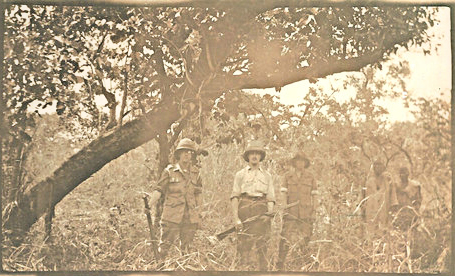
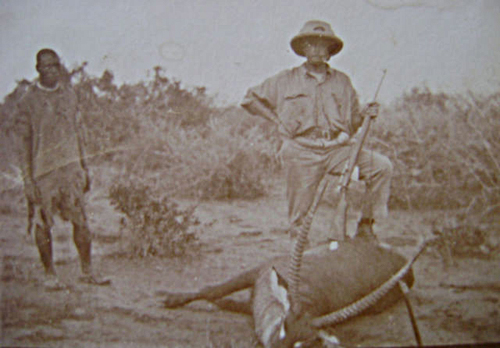
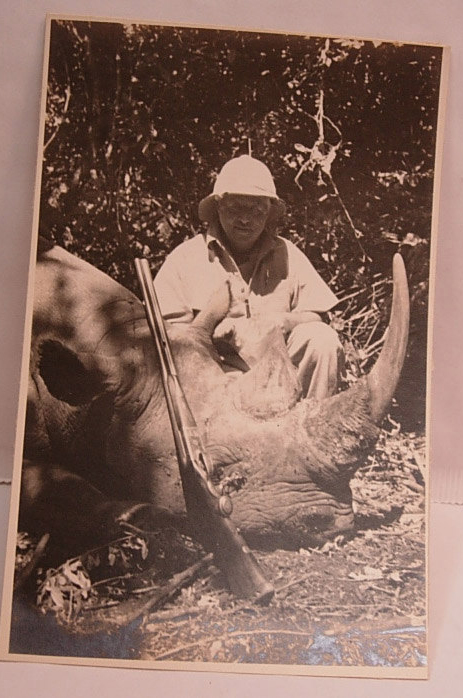
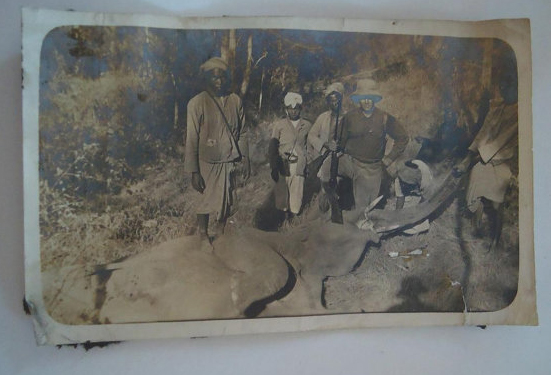
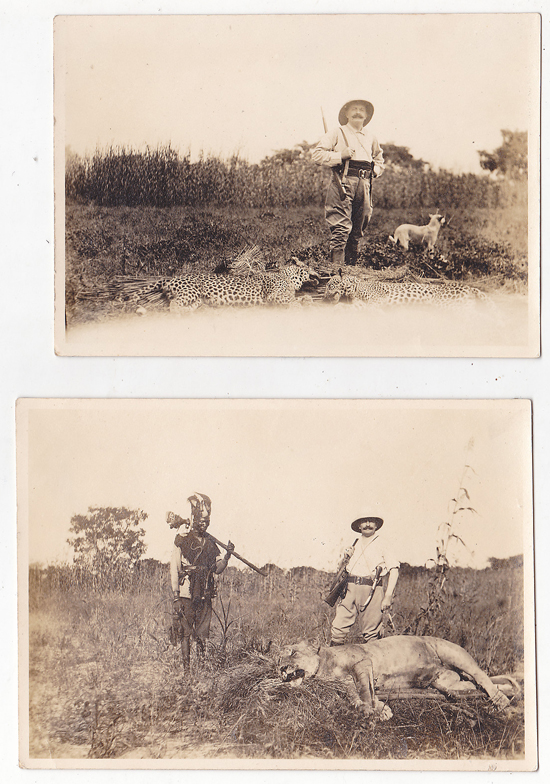
Hello Shea,
Congratulations on one of the most interesting and insightful articles I’ve read in years regarding the psyche of the big game hunter. Years ago I was engaged in the industry (yes, it is still an industry) of big game hunting here in Canada and in the United States and can say with first-hand knowledge that you could not have been more accurate had you been there in person.
Your photographic collection is absolutely first rate, capturing the very essence of the moment.
Thank you for a most interesting read.
Regards
Brian
Extremely humbled, Brian. I was a fan before I was a contributor, so it was a joy to write.
Are you a hunter in the industry or a supplier? I’m fascinated! A few years ago I attended a gun convention in search of old flintlock pistols and was surprised by how alive big game hunting is today, as you said. There were tables as long as the Last Supper’s full of safari hunting books, of which I would have swept up were they not close to $50 a book.
Although not a hunter myself, I’m surely a fighter. It would be an honor to be by your side on another Canadian or American adventure.
Warmly,
Shea
P.S. I sheepishly have to admit that that’s hardly half of my collection…I’ve been attempting an “eBay fast” this month! You can count my ribs!
Bravo Shea
you’ve shown these stuffed shirts how to write an interesting and engaging article.
That’s my girl, so proud of your growth. You have developed into one of the best and most insightful writers that I know. What an interesting and well developed article! Love the pictures, love that you are on the hunt or I should say on the EBay wagon and love you!
Honored, David. Thank you so much. I’m sure my blogging crew could do plenty better than me, but I do enjoy giving the ol’ pith heads a royal run for their money.
Mrs. Williams — Always your girl. I love you too. (So proud to say my former history teacher right there, everybody! She must be checking my facts!)
Hi Shea,
your ideas on the golden age of big game hunting are fascinating. If I’ve thought about it at all the hunting was just seen as furniture for a good story, like Rider Haggard’s “King Solomon’s Mines”.
As it happens I am currently re-reading another Edwardian story, John Buchan’s “The Three Hostages” – I think it is the fourth of his Richard Hannay novels. If you haven’t come across Buchan his most famous novel is “The Thirty Nine Steps”. The craft of the hunter figures often in all the Hannay novels. In this one, Hannay is now Sir Richard Hannay, KBC, retired General and gentleman farmer in the English Midlands, in the 1920s, looking forward to a quiet retirement and plenty of hunting and fishing. He is very much Edwardian in his thinking, like I expect Buchan himself, who was born in 1875 and ended his days as Baron Tweedsmuir, 15th Governor General of Canada. Hannay is perhaps the epitome of what an Edwardian “sportsman” should have been; courageous, honest, dependable, devoted to his wife and child, self-sacrificing for the good of friends and country. And he loves hunting and fishing. He doesn’t get his quiet life and hunting, being called upon to hunt bigger game than trout, stags or even elephants, and ends up being himself hunted over the Scottish highlands.
Hannay of course has his faults; a fairly benign streak of racism, and the conviction that the British Empire and democracy is the best the world has ever developed. Perhaps the two are much the same. I suspect they were not seen as faults by the Englishmen of his age. I remember C S Lewis’s comments in his “On the Reading of Old Books”; long quotation, but apt – “None of us can fully escape this blindness, but we shall certainly increase it, and weaken our guard against it, if we read only modern books. Where they are true they will give us truths which we half knew already. Where they are false they will aggravate the error with which we are already dangerously ill. The only palliative is to keep the clean sea breeze of the centuries blowing through our minds, and this can be done only by reading old books. Not, of course, that there is any magic about the past. People were no cleverer then than they are now; they made as many mistakes as we. But not the same mistakes. They will not flatter us in the errors we are already committing; and their own errors, being now open and palpable, will not endanger us. Two heads are better than one, not because either is infallible, but because they are unlikely to go wrong in the same direction. To be sure, the books of the future would be just as good a corrective as the books of the past, but unfortunately we cannot get at them.”
best wishes,
Steve
Steve, what an utter delight.
Please forgive the less-than-speedy reply, as I anxiously read your comment on my phone early yesterday morning and was perhaps still mingling with characters from my dreams before taking it all in.
Firstly it is a pleasure to meet you. I’ve heard of you through Stuart, who I assume you’ve witnessed groan and gripe about how frequently I insist on writing him. I’ve grown very fond of the Bates family name.
Secondly, I’m tickled both by your praise of my article and your liking of books just like me, namely historical/Edwardian studies. King Solomon’s Mines, as you lightly mentioned, is actually one of my favorite works as it was written nearly a hundred years ago and yet its prose is so fresh and deep that it feels like the adventurers still live today. Sometimes I wish that they did (sort of like what Lewis was saying in that quote you referenced, which we’ll get to in a moment). But Hannay seems to be a mirror of those spirited characters – as I said before I don’t share his love of hunting but I do love to fish. One of the few sports I am able to mange with my own two hands. I gave up somersaults long ago.
But regarding your literature taste I would recommend two other historic books to you by Tim Jeal — “Explorers of the Nile” and “Stanley,” which is a fascinating biography of the explorer I mentioned, Henry Morton Stanley, whose life was stilted by numerous insecurities and misconceptions that contrast with the bold and brash reputation he accumulated.
Lastly, I picked up on your mention of C.S. Lewis and learned through Stuart that you and I share a mutual reverence of him. My favorite quote of is, however unrelated to the topic this may be, “You don’t have a soul, you are a soul. You have a body.”
That, and, of course, “You have never spoken to a mere mortal.”
Indeed, my immortal friend. Thank you very much again. God bless and my warmest regards to you.
Shea
I’ve purchased a percussion double barrel rifle from the 1850’s who’s proof marks prove it to be from England but, there is one proof/stamp that has the weapon experts perplexed…. It is a tiny man wearing a pith helmet/hat. Have you come across any pith wearing makers marks? Enjoyed very much your writings. Must say, I just completed a 1905 copy of Teddy Roosevelt’s western movement of the English speaking peoples and have found a new favorite author for now.
Best Regards
Rer
Hi Robert,
Humbled to receive your comment, and I must say I’m more than impressed with your purchase and would love to see that makers’ label. While I like to pretend I’m versed in pith helmets and their symbolism, I readily admit I’m more of an admirer and an enthusiast (and dreamer, needless to say – I’ve fictionalized the old rifles in my novel rather than pulled from the real artisans), but would put my money on Stuart or Peter to possibly provide some insight into that new artifact of yours. For direct contact, check out the “About Us,” tab, otherwise they might hop on this thread if they see it active.
Thanks for your interest in my article – keep reading the blog; there are much more intelligent and interesting pieces here than the one I’ve concocted. 🙂
Warmly,
Shea C. Megale